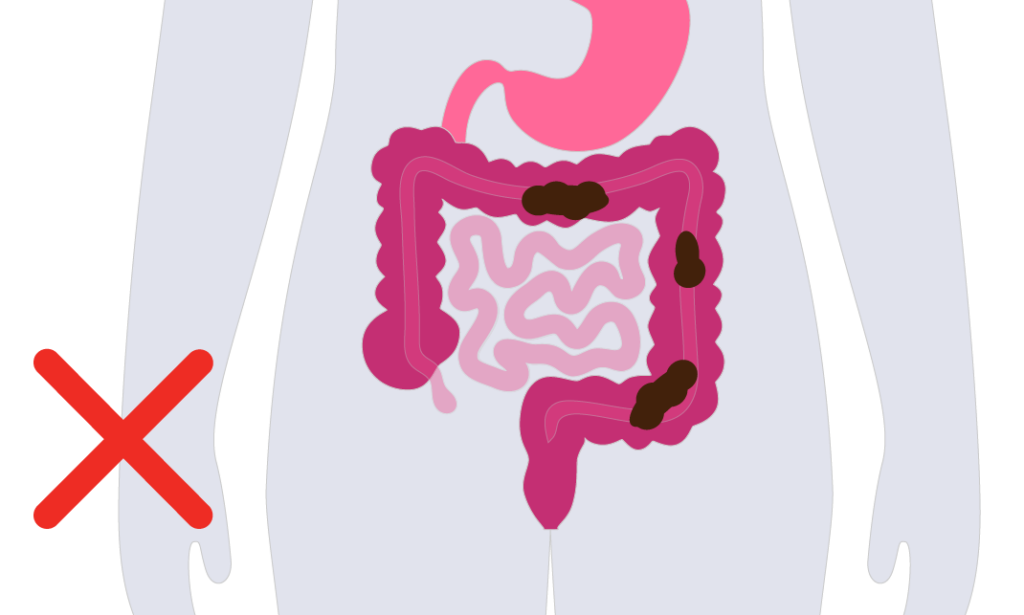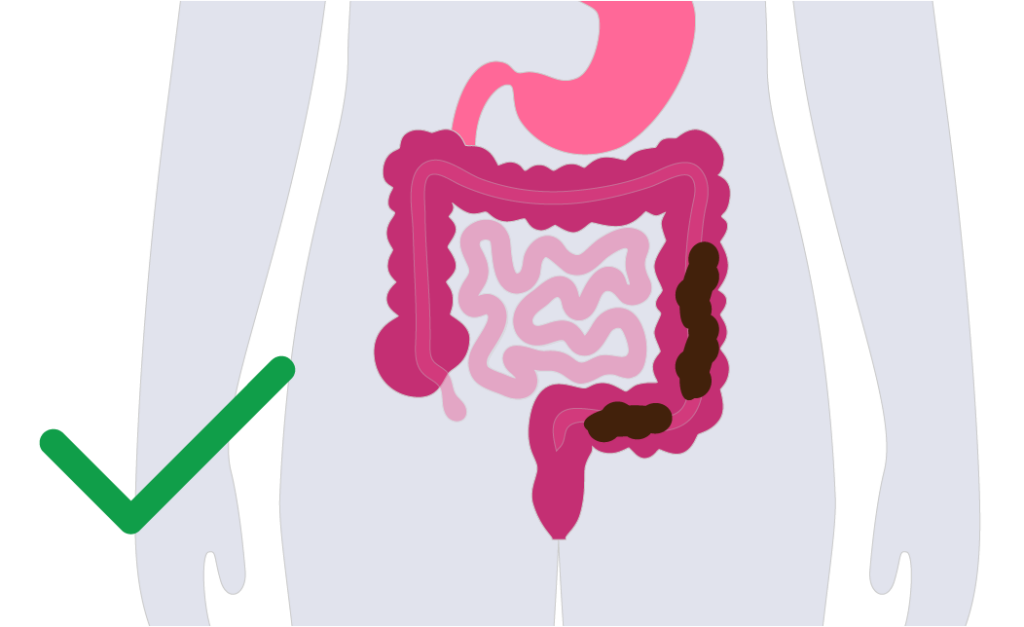Right place
This guideline refers to where the faeces is in the bowel, when the person is ready to go to the toilet.
If the faeces are too high in the bowel, it is unlikely that elimination will take place while the person is sitting on the toilet. The faeces may work itself down at a later time, resulting in an unplanned bowel movement. Alternatively, if the faeces are too low in the bowel, there may be an unplanned bowel motion prior to getting to the toilet.

The faeces are too high in the bowel, making elimination over the toilet unlikely.

The faeces are in the right place in the bowel, meaning the person is ready to go to the toilet.
The most common method for influencing Right place is stimulating the bowel – using either food, medication and/or activity.
Food
Specific foods and regular meals can stimulate the bowel to push waste through to reach the Right place faster. In some individuals, implementing specific, targeted dietary strategies can reduce or prevent the need for bowel medications.
Eating enough fibre is important for motility. Fibre provides bulk and gives the digestive tract muscles something to ‘grip’ onto, pushing waste through the bowel more effectively. Fibre needs fluid to work effectively, so drinking plenty of water is vital.
Most people can readily identify foods that stimulate the bowel. These are the foods that had someone going to the toilet before their spinal cord injury and will be different for everyone. Commonly named examples are:
- prunes
- kiwi fruit
- large serves of fruit, fruit juice or dried fruit
- sugar-free chewing gum, lollies or mints
- spicy foods
- liquorice
- nuts and seeds
- alcohol and caffeine
Eating large or frequent servings of these foods may lead to unplanned bowel movements. Alternatively, some of these foods can help to achieve a regular bowel routine if consumed in moderation.
Medications
Medications that stimulate the bowel are also referred to as aperients. Common aperients are senna (Senokot) and bisacodyl (Dulcolax) tablets or drops. Senna or ‘sennosides’ are found in many different brands and strengths over the counter and at health food shops. The table below shows some of the common medications available and the approximate compared strengths.
| Drug | Senna dose | Measure | Other ingredients |
|---|---|---|---|
| Senokot Tablets | 7.5mg sennosides B OR 412mg senna leaf | 1 tablet | |
| Coloxyl & Senna | 8mg sennosides B OR 440mg senna leaf | 1 tablet | 50mg coloxyl per tablet |
| Laxettes | 12mg sennosides B OR 660mg senna leaf | 1 tablet | |
| Agiolax | 15mg sennosides B OR 825mg senna leaf | 5g dose or 1 tsp | Fibre (psyllium husk & Ispaghula), swallow whole |
| Prunelax Extra Strength | 15mg sennosides B OR 825mg senna leaf | 1 tablet | Natural Plum |
| Nulax | 20mg sennosides B OR 800mg senna leaf | 10g or 2 tsp | Dried fruit |
| Herbelax | 24.5mg sennosides B OR 1.35g senna leaf | 1 tsp | Liquorice, dill, psyllium husk 31mg per teaspoon |
| Prunelax paste | 30mg sennosides B OR 1.2g senna leaf | 7.5g or 5ml measuring spoon | Prunes, apple pulp, flax seeds, honey, sucrose |
These medications work by stimulating peristalsis, with the best effects occurring between 10-16 hrs after taking the medication. The timing of these should be adjusted to suit the bowel routine.
How to use and adjust a stimulant medication: an example
If toileting at 8am, the senna dose should be given at approximately 8pm the night before.
More than the recommended dose (approximately 30mg of sennosides daily) can overstimulate the bowel, causing problems with the coordinated movement of the faeces. This may result in ‘churning’, instead of moving, faeces through the intestine.
Will the person always need to take bowel medication?
Some people may be able to reduce or stop some of their bowel medications, whereas other people may need to continue them long-term to help maintain a regular bowel routine. This will be different for everyone and can also be influenced by diet, lifestyle, other medications, and activity.
Activity
Gravity and sitting upright can aid in digestion. Movement – whether moving around the house, going out to the shops or doing exercise – can aid in intestinal motility too. Any movement is better than none.